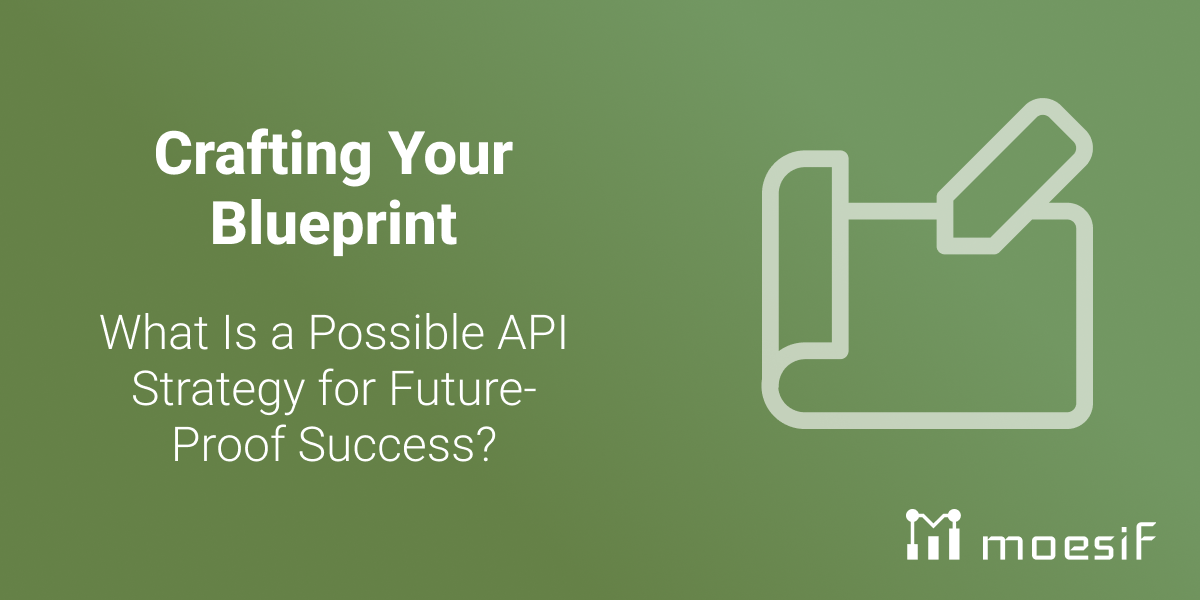Crafting Your Blueprint: What Is a Possible API Strategy for Future-Proof Success?

What is a possible API strategy and why is it critical to your business’s success? An API strategy encompasses planning, executing, and managing APIs to enhance interaction between applications and services. Focused on aligning technology with business goals, it improves end-user experiences, fosters innovation, and drives growth. By integrating an API strategy into your digital transformation efforts, businesses can achieve significant advancements. In this article, we dissect the pillars of an API strategy, providing actionable insights for businesses ready to harness the potency of API-driven transformation.
Key Takeaways
- A successful API strategy aligns API development with business goals, focusing on user and developer experiences to foster innovation and facilitate seamless integration and data exchange within digital ecosystems. This includes benefits such as cloud migration and legacy modernization, which are essential for maintaining competitive advantage.
- API governance is crucial for managing the API lifecycle, encompassing design, development, deployment, and retirement while maintaining security, compliance, and performance through proper management platforms and tools.
- Securing and monetizing APIs are integral to protecting digital assets and creating new revenue streams, with the implementation of secure protocols and exploration of monetization models being key to long-term, sustainable success.

Deciphering API Strategy Essentials

In the digital landscape, an API strategy serves as the liaison between complex coding and strategic vision. It’s not simply about managing APIs but about orchestrating a symphony where each note—the API call—resonates with the business’s grand composition. A sound API strategy is the backbone of a successful digital enterprise, harmonizing API development with overarching business aims and objectives. It encapsulates the essence of API architecture, dictating the scope and quality of interactions that enhance user experiences and drive value.
Creating an API-first strategy goes beyond conventional software development methods. It requires an API blueprint that is both scalable and designed with the future in mind, focusing on enabling data exchange and exposing functionalities in a way that fuels digital ecosystems and innovation. An effective API strategy addresses the needs of API developers, applications, users, and the business in a holistic manner. As we delve into these fundamentals, let’s begin by anchoring our enterprise API strategy in the bedrock of clear business goals.
Defining Your Business Goals
A firm business strategy serves as the cornerstone for every enterprise API strategy. When the cogs of API machinery align perfectly with the wheels of business objectives, the result is a seamless journey toward success. Articulating these goals within your API documentation is not just a box-ticking exercise; it’s a strategic move that ensures your technological prowess marches in lockstep with your business ambitions.
Whether you’re streamlining processes, expanding into new business models, or scaling up operations, your API’s role is to support and accelerate these aspirations. So before diving into the technicalities of API development, pause to reflect on your destination. What new business models are you aiming to enable, and how can your API catalyze that transformation? A well-aligned API strategy can open doors to innovative new business models, driving growth and competitive advantage.
Prioritizing User and Developer Experience
In a digital environment saturated with application programming interfaces, how can you make your API distinct? By offering an exceptional experience to both API users and API developers. It’s about creating an environment where managing APIs is not a chore but a delight, and where API development is a streamlined, well-supported process. An application programming interface that effortlessly facilitates connectivity and automation within operations becomes not just a tool, but a cornerstone of business agility.
Imagine a thriving developer community, where ideas exchange hands as easily as API calls. Here, the developer portal is not just a repository of information, but a nexus of engagement, supporting the development team with clear documentation, developer tools, and a sandbox for experimentation. Prioritizing this experience is not just about attracting third-party developers; it’s about fostering a digital ecosystem where innovation flourishes. Third-party developers play a crucial role in expanding the reach and functionality of your API, contributing to a vibrant and dynamic digital ecosystem.
Architecting Your API Ecosystem

The design of your API ecosystem meticulously outlines the route for data to navigate through your digital operations. It’s the scaffolding that supports efficient data sharing and interoperability, enabling applications to converse in a universal language. This ecosystem is not just about building APIs; it’s about crafting modern APIs that can sustain the dynamic requirements of cloud migrations, legacy modernizations, and the omnipresent demand for seamless data exchange.
By nurturing this ecosystem, you invite API developers to join your ranks, turning them into partners who enrich your platform with content, tutorials, and use cases. Such collaboration fosters a robust API strategy that thrives on iterative development and thriving developer communities. After all, APIs aren’t just technical constructs; they’re the very conduits that carry the lifeblood of your enterprise API strategy, integral to the operation and scalability of any digital SaaS offering.
Establishing API Governance
The significant influence of your API ecosystem necessitates a solid API governance framework. API governance is the compass that guides your API strategy, ensuring a harmonious balance between innovation and control. It is a comprehensive discipline that includes setting organization-wide standards, establishing API lifecycle management, and keeping a vigilant eye on ecosystem management.
In the world of enterprise API, compliance is king. A governance framework enforces policies and regulations, conducting regular security audits to protect your API architecture from internal and external threats. An API management platform, like an astute overseer, centralizes this oversight, automating API creation and enforcement of security measures to prevent duplicative work and guarantee consistency.
Managing API Lifecycle
Envision the API lifecycle as a celestial journey, from its inception in the design nebula to its ultimate retirement in the expansive internet cosmos. Managing this lifecycle is a testament to an enterprise’s commitment to an entire API lifecycle approach, encompassing design, development, deployment, and even the eventual sunsetting of APIs. It’s a cyclical saga that includes the key phases of design, build, release, and runtime governance, each as critical as the next.
A design-first philosophy ensures that API design and development is not a haphazard affair but a strategic process with a clear blueprint in place. This is crucial for maintaining backward compatibility and providing API developers with clear, strong documentation, which in turn minimizes disruptions for API users. The goal is not just to build APIs, but to nurture them through their lifecycle, allowing for seamless evolution and adaptation.
The Role of API Management Platforms

In the digital orchestra of APIs, an API management platform takes on the role of the conductor, harmonizing multiple tasks associated with API lifecycle management. These platforms are not just about managing APIs; they’re about empowering them with features like:
- API gateways
- Developer portals
- Analytics
- Security features
These features streamline development, testing, and deployment. With a solution like Astera API Management, developers engage in a visual, code-free dance of designing, testing, and monitoring APIs, all the while ensuring a smooth performance throughout the API lifecycle.
But it’s not just about ease of use. API management platforms offer several benefits, including:
- Acting as guardians, offering API providers and API consumers a secure and controlled environment
- Safeguarding the sanctity of API usage, backed by centralized logging and real-time performance analysis
- Upholding the strictest security protocols
Choosing the Right Platform
Choosing the right API management platform must be a perfect fit for your organization’s API strategy, aligning with your development practices and offering seamless integration with existing workflows. It should empower your API initiatives with the right tools for control and visibility into API usage, serving as the backbone of effective API governance and monitoring.
But, how does one navigate the landscape of API management platforms to find the one that truly resonates with their business strategy? It’s a delicate balance of features, scalability, and compatibility, to manage APIs effectively, thus ensuring a well-defined API strategy that supports your organization’s goals.
Securing and Monetizing Your APIs

API security is a multi-faceted endeavor, involving authentication, authorization, and encryption to safeguard sensitive data from unauthorized access and manipulation. It’s about building a fortress around your API calls, ensuring that trust is preserved and business value is protected.
Yet, beyond the walls of security lies the land of opportunity—where API strategies unfold into new revenue streams. Monetization is the art of turning API access into gold, whether through direct charging mechanisms or by developing new business models that leverage the power of APIs. This approach not only secures the present but also paves the way for future prosperity, allowing API providers to expand their horizons and tap into platforms such as IFTTT and Zapier to reach non-technical users.
Crafting Secure Protocols
Creating secure protocols involves several important steps:
- Crafting a complex web of digital protections
- Implementing a centralized OAuth server for token management
- Implementing fine-grained access control at the API level
- Employing JWTs for internal communication
- Maintaining opaque tokens for external interactions
By following these steps, you can ensure the integrity and confidentiality of your protocols.
Encryption is the cloak that shields data transmissions, with HTTPS and JSON Web Key Sets being the threads that fortify this cloak against prying eyes. An API gateway, much like the gatekeeper of a citadel, enforces security policies and manages traffic, while firewalls add an extra layer of defense. Remember, in the realm of APIs, internal threats lurk just as external ones do, making it crucial to implement protections across the board. A zero-trust model reinforces this security posture, denying access by default and demanding concrete policy fulfillment for any trust to be granted.
Exploring Monetization Models
The pursuit of monetization goes beyond simple profit-seeking; it’s a strategic effort to uncover new opportunities within your API ecosystem. With a staggering 65% of API providers reporting revenue generation from their APIs, the value proposition is clear. Monetization can take many forms, from bustling API marketplaces to the precision of usage-based pricing, all the way to tailored payment plans that fit a variety of business models.
These models do more than just generate income; they enable ecosystems to thrive, supporting a network of products and services that complement each other. It’s a virtuous cycle where every successful API call not only fulfills its immediate purpose but also contributes to a larger tapestry of revenue and growth.
Fostering Developer Engagement

In the digital arena, API developers are the main players, and nurturing their participation is crucial for any API initiative’s success. A thriving developer community serves as a self-sustaining support network, a place where API development is not only productive but also collaborative and innovative. Key to this is providing a rich suite of resources, from clear documentation to sandbox environments and code samples, all designed to encourage adoption and creativity.
But engagement doesn’t end with resources. Visibility is crucial, and employing SEO and marketing techniques to enhance the discoverability of APIs ensures that developers can easily find and interact with your offerings. Coupled with a marketplace for third-party applications and services, this approach not only engages developers but also encourages them to take ownership of their creations, further enriching your digital ecosystem.
Building a Developer Portal
The developer portal serves as the grand platform where API developers come to showcase their skills. It’s where the magic happens, where API management platforms reveal their full potential, and where API gateways become gateways to opportunity. A well-designed API strategy includes a developer portal that is a treasure trove of documentation, SDKs, and testing environments, all accessible and user-friendly.
It’s a one-stop shop for the development team, where software development is not only about developing APIs but also about sharing, learning, and innovating. A developer portal is a bustling hub of activity, offering tools and support that empower developers to create, refine, and perfect their creations.
Creating Feedback Channels
In the ever-changing world of APIs, feedback serves as the navigation tool for ongoing enhancement. Understanding how users interact with your APIs and tailoring them to meet their needs is paramount. Creating feedback channels is not just about receiving praise or criticism; it’s about engaging in a dialogue that leads to iterative enhancements, new features, and optimization of existing functionality.
This ongoing conversation with users turns pain points into waypoints on the road to excellence. It ensures that your API strategy remains responsive, agile, and attuned to the evolving landscape of digital needs. Embrace feedback, and watch your APIs flourish as they adapt and grow in response to user insights.
Optimizing API Performance and Analytics
To guarantee that your API strategy achieves optimal performance, you need to harness the sharp insights of an analyst and the meticulousness of a performance engineer. Performance optimization and analytics go hand in hand, providing a panoramic view of how your APIs are functioning in the wild. Through the use of monitoring and analytics tools, you gain the ability to see beyond mere API calls and delve into user behavior, usage patterns, and performance bottlenecks, using these insights to steer future strategy and enhancements.
Analytics are the crystal ball through which future needs are anticipated, allowing businesses to cater to customer preferences, tap into market trends, and drive operational efficiency. Performance testing, an essential part of this analytical toolkit, involves load testing, stress testing, and benchmarking, ensuring that your API can withstand growth and increased stress without faltering.
Tracking and Improving API Metrics
In the API landscape, metrics serve as the markers that track the progress of each API request. The quintessential metrics that define an API’s service quality are:
- Response time
- Latency
- Failed request rate
- Throughput
- Availability
Assessing these metrics through percentiles like the 50th, 75th, and 99th, paints a more vivid picture of an API’s performance, unmasking extreme cases of high response times that could deter users.
But tracking metrics is only the first step; the real magic lies in using those insights to improve. Advanced API management tools offer analytics and reporting features that shed light on API usage patterns, helping you:
- Identify popular services
- Inform your development priorities
- Monitor for abuse
- Manage throughput
- Set threshold-based alerts for quick response to anomalies
All of these are part of a robust strategy to ensure your APIs perform consistently and reliably.
Responding to API Analytics Insights
Analytical insights go beyond simple numbers; they represent the feedback of your API consumers and the reflection of your API strategies in operation. Custom reports tailored to specific business needs help you decipher these voices, transforming data into actionable intelligence. Accessing analytics data programmatically opens a gateway to precision, allowing for targeted insights that can refine your API initiatives.
These insights can take many shapes—custom queries that fetch subscription IDs, usage statistics, or other targeted metrics that fit your analysis goals. The flexibility of scheduling reports for download in formats like CSV ensures that insights gleaned from API metrics are not just understood but also shared and acted upon across the organization.
Integrating APIs into Your Digital Transformation Journey
The digital transformation journey resembles an adventure into unexplored terrain, and APIs serve as the advanced tools that pave the way forward. They dismantle the silos of yesteryear and lay down the digital rails for seamless data exchange, propelling organizations forward with IT enablers that redefine the landscape. The integration of APIs into this journey is not a mere tactical move but a strategic leap that aligns with digital initiatives, infusing them with agility and innovation.
As the world becomes increasingly connected, APIs are the conduits that enable organizations to not just participate in but shape the digital ecosystem. By weaving APIs into the fabric of digital transformation initiatives, businesses can enhance decision-making, streamline operations, and ensure that their digital presence is both vibrant and resilient. This integration fuels multi-platform excellence, empowering businesses to provide a seamless and consistent customer experience across all touchpoints.
Aligning APIs with Digital Initiatives
Alignment is essential for a smooth digital transformation, with APIs serving as the connecting links between business initiatives and technological capabilities. An API strategy that is in sync with digital objectives enables seamless integration, ensuring that every API call is a step towards a larger goal. Leveraging API-led connectivity fuels multi-channel success and facilitates e-commerce transformation, ultimately enhancing customer engagement and revenue.
By streamlining operations and modernizing systems, APIs become the backbone of your digital initiatives, supporting the growth and evolution of your organization. They are the instruments that orchestrate a digitally transformed business, providing the agility and scalability needed to thrive in the digital age.
Leveraging APIs for Competitive Advantage
In the pursuit of innovation, APIs act as accelerators that thrust businesses past their competitors. They enable quicker integration of cutting-edge technologies, allowing businesses to be more responsive to market shifts and consumer demands. An API-first strategy in software development ignites a cycle of continuous innovation, streamlining costs and enabling rapid implementation of customer-centric changes.
The advantage of leveraging APIs extends beyond the technical realm; it translates into a broader reach across new customer segments and a deeper engagement with the market. By embracing an API-centric approach, businesses can carve out a distinctive presence in their industry, fostering innovation and expanding their services through seamless integration with partners and platforms.
Summary
As we conclude this exploration of the API landscape, it’s clear that a robust API strategy is the foundation of digital success From establishing well-defined business goals and prioritizing user experience to crafting secure protocols, monetizing effectively, engaging developers, and leveraging analytics, each step has been a building block towards creating a resilient, future-proof API ecosystem. Embrace these strategies, and you’ll not only elevate your APIs but transform them into engines of innovation and growth, ready to power your digital transformation journey.
Organizations looking for the best tools to support their API management can leverage Moesif’s powerful API analytics and monetization capabilities. Moesif easily integrates with your favorite API management platform or API gateway through one of our easy-to-use plugins, or embed Moesif directly into your API code using one of our SDKs. To try it yourself, sign up today and start with a 14-day free trial; no credit card is required.






